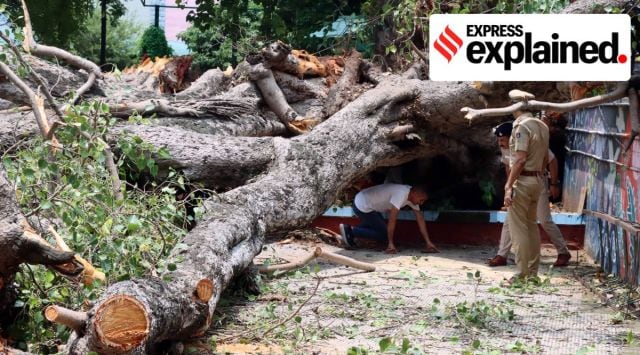What is a ‘heritage’ tree, and how are they different from others? Who is responsible for the maintenance of these trees? The Indian Express explains.

What is a ‘heritage’ tree?
In Chandigarh, a tree with an estimated age of 100 years, or more, is declared a ‘heritage property’.
Story continues below this ad
To establish the age of the tree, the administration, through its Forest and Wildlife Department, relies on old records related to the existence of the tree. Though the age of the tree can be calculated using a carbon dating technique, the age of Chandigarh’s heritage trees are based on other proof, such as old maps and records.
The process to declare trees as heritage was completed after a three-year exercise in December 2017.
The giant peepal tree, which was around 250-years-old, was one of the oldest heritage trees in Chandigarh.
How many heritage trees does Chandigarh have?
Chandigarh had a total of 31 heritage trees before Friday’s tragedy.
Story continues below this ad
 Heerakshi was a Class 10 student.
Heerakshi was a Class 10 student.Of the 31 trees, 15 are peepal (Ficus religiosa), seven are Bargad (Ficus benghalensis), there are four Banyans (Ficus benghalensis) and mango trees (Mangifera indica), and one Imli (Tamarindus indica).
At least nine heritage trees are situated inside schools, or just outside their premises. Of these nine, four are at the Government Girls Model Senior Secondary School in Sector 18.
What makes heritage trees different from others?
Declaring a tree as heritage property accords it special status.
“Heritage trees are guarded. A board is installed near each tree with information on their age, life history and importance,” a senior forest officer said. “If construction is obstructed by a heritage tree, either in the middle of the road or in personal property, permission will be denied for the construction,” the officer added.
Story continues below this ad
According to a notification dated December 21, 2017, “The department of tourism, UT Chandigarh, shall plan and organise heritage walks… in order to educate and sensitise people towards heritage trees of the city.
“The engineering department, and municipal corporation shall not cut or prune these heritage trees without prior approval of the UT Chandigarh administration,” it added.
 A board with information on the heritage tree. (Express Photo: Kamleshwar Singh)
A board with information on the heritage tree. (Express Photo: Kamleshwar Singh)
Who is responsible for the maintenance of heritage trees?
The responsibility is divided in three parts.
Heritage trees situated within the boundaries of any institute or personal property are in the responsibility of the engineering wing of the UT administration.
Story continues below this ad
Tress situated outside the boundaries, like on roads, parks etc, are the responsibility of the municipal corporation.
Heritage trees situated in forest areas come in the jurisdiction of the forest department.
The notification states, “The departments/institutes on whose premises these heritage trees are standing shall be responsible for its protection, preservation and conservation in coordination with Department of Forest & Wildlife, UT Chandigarh.”



 Heerakshi was a Class 10 student.
Heerakshi was a Class 10 student. A board with information on the heritage tree. (Express Photo: Kamleshwar Singh)
A board with information on the heritage tree. (Express Photo: Kamleshwar Singh)




































